After my success on a Glacier Peak car-to-car two weeks ago, I wanted to go for a Rainier one, which would be easier. So, I thought I had it in the bag.
I wanted to do the Emmons, but that and other routes were degraded thanks to the heat wave. The Disappointment Cleaver would be the safest and easiest for a car-to-car blitz.
Rainier has some serious glacial terrain, and so I talked a partner of mine into going. He lives in a tiny cabin on one of the picturesque islands in Puget Sound. A gorgeous setting. I splurged for a ferry and met him there.
With a two-person team, crevasse rescue is a more difficult and risky endeavor. So, we practiced some two-person roped travel and rescue tactics. Alpine butterflies in the rope, adjusting kiwi coils, and preparing an anchor while lying on the ground. We were pretty set and confident.
I went to sleep, and the next morning we woke up and drove to Paradise. After Rainier I’d be going east to Colorado, so we’d be taking separate cars.
This was a Friday, and there wasn’t traffic getting into Paradise. We reached the parking lot and went into the ranger station to get permits.
If you’re doing Rainier car-to-car, getting a permit is guaranteed — if you bother to register. Even though we’d be on a day trip, the permit needed to have a campsite on it. The only “camp” available was the summit crater. So, we took our summit crater campsite permits back.
We refreshed two-person crevasse rescue techniques again, this time on a steep hillside. Then, around 8 p.m., we went to sleep in our cars. Our alarm would be set for around 11 p.m.
A few hours later, we woke up. We marched up the empty trail to Panorama Point, seeing no one. A rarity, but it was near midnight after all.
We soon reached the Muir snowfields. Now it was a game of “follow the bootprints” to Camp Muir. A few hours later, we reached Camp Muir in darkness. 4,500 feet of gain, 4,500 feet to go.
There were about 20 tents here, mostly guided parties with several unoccupied. The mountain would be pretty empty — it was a Saturday morning after all. There was activity as climbers were preparing for their own ascents. We reached at the perfect time.
We roped up and melted snow for water. I had just bought an MSR reactor, and it was perfect. It produced 3 liters of water in almost no time. Then, we started up.
The boot-pack was so well worn that we never had to put on crampons. We puttered along. This was my first time on the Disappointment Cleaver route, and it felt artificial, for lack of a better word. There were wands and blazes marking the route, which took away from the experience. It dumbed down the mountain. Perhaps the Emmons route is the best “easy” way to go for a true climb.
After the first bit of glacier, we had to cross over a rock outcropping — the Ingraham Cleaver I believe. We shortened the rope, and made quick work of it.
We returned to a glacier, and the terrain was much cooler now. We were above Ingraham Flats camp, and the terrain was gnarly. Giant crevasses with sketchy snow bridges, collapsed seracs, the whole shebang. The beauty was incredible.
Unfortunately, I seemed to hit a wall around 11,000 feet. My pace was slow because of that. The first 5,000 feet of ascending went by in blazing speed, but now here I was slugging on. I blamed altitude sickness, but I didn’t understand how I’d get it at only 11,000 feet.
After crossing this glacier, we reached the Disappointment Cleaver — the namesake of the route. I knew to watch out for loose rock here, but that’s an understatement. This is by far the loosest rock I’d stepped foot on. Maybe it’s naturally like that, or maybe the hundred of climber footsteps jostle all the rock. It took a ton of mental effort on our part not to drop any rocks. There were less than a dozen people on the cleaver. Even so, we’d have to duck our heads on occasion as a party ahead yelled “Rock!” I couldn’t imagine this on a weekend, where there would be a hundred climbers on the cleaver, dropping rocks on each other.
For some reason, the party below us was climbing at our feet. We offered to let them pass, but they said our pace was good. Though we were careful about rock-dropping, they were way too close to us. Maybe they just trusted us that much.
We reached the top of the cleaver at sunrise, and I was done. I’d been pushing through what I believed was altitude sickness for a while. Now, I was nauseated, light-headed, and gasping for breath. We discussed and decided to turn around. Even if I could make it to the summit — a mere 2,000 feet higher — it would be too late in the day.
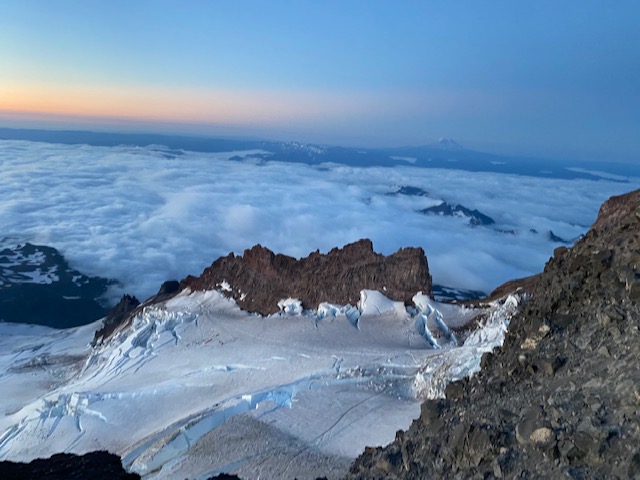
On the bright side, we sat for a half-hour and watched the sunrise over Little Tahoma — taking some spectacular photos.
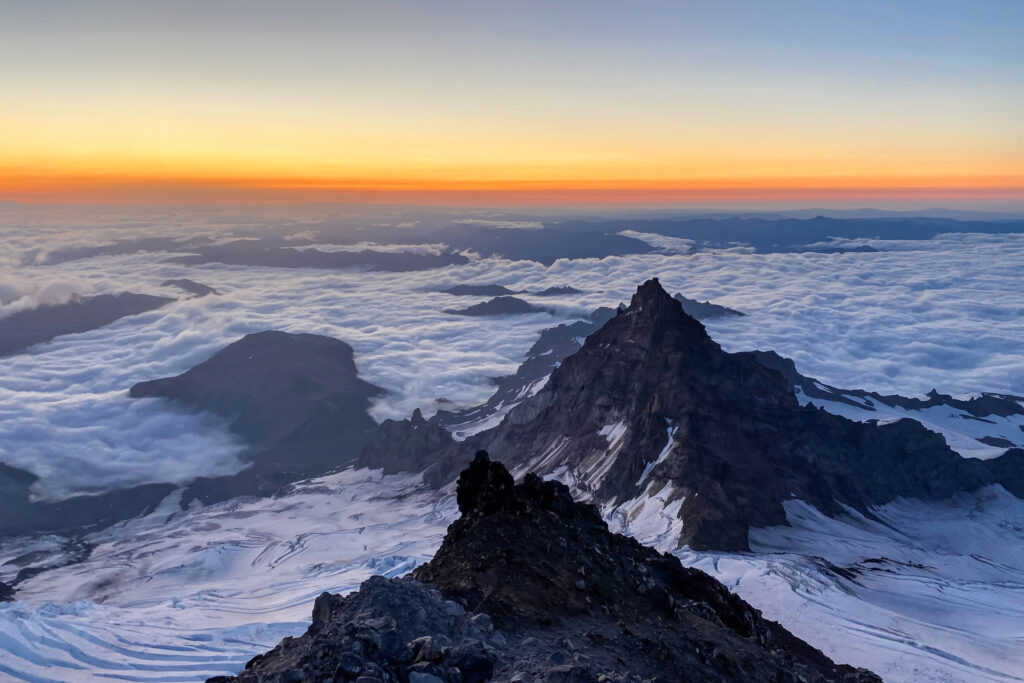
Then, we descended, retracing our route. Now, there was no one above us on the cleaver to drop boulders on us, And, no one below for us to drop boulders on. Always welcome.
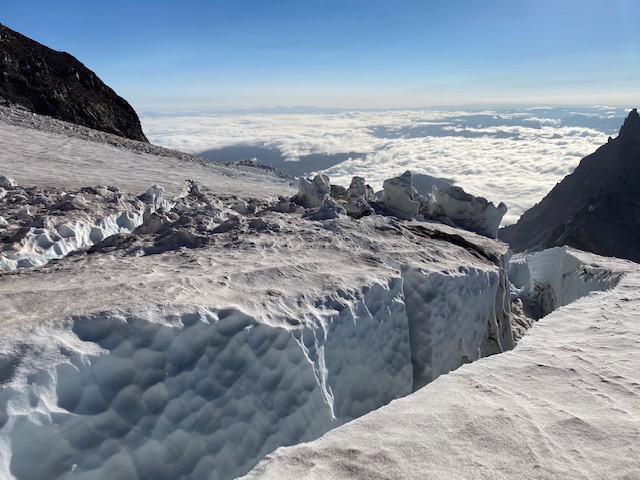

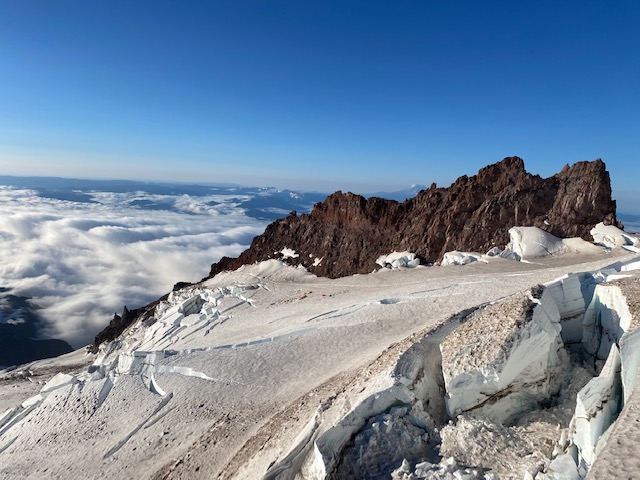
We reached Camp Muir. We unroped and packed our glacier gear. We started descending the Muir Snowfield now.
The snow was soft now, and we glissaded several thousand feet of the descent at absurd speeds. Though it was a no-summit day, the quality of this glissade made the whole day magical.
When we left the snowfields, it was chaos. I don’t use this word lightly, so believe me when I say it was a zoo. It was a Saturday morning, and there were people on the trail as far as the eye could see. I usually stay away from National Parks — at least the popular parts — and this confirmed my reasoning ten-fold. Our pace was down to zero as we literally zig-zagged between people on the way down.
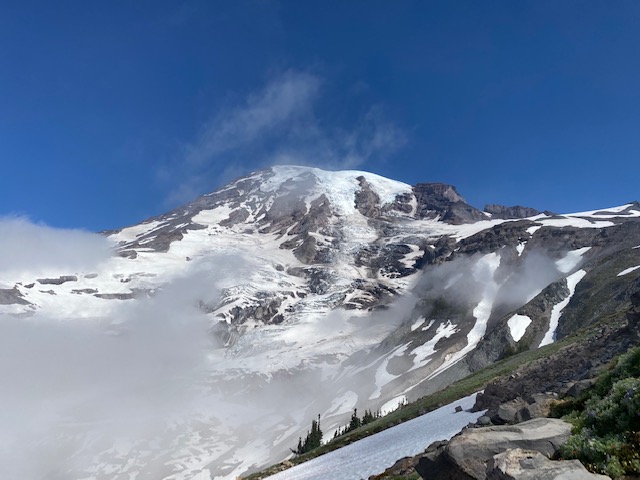
Plenty of the traffic was climbers as well, going to Camp Muir. I counted over 150 climbers. After seeing that, It’ll be hard to convince me to climb the Disappointment Cleaver on a weekend. Weekdays are where it’s at, or other routes.
When we reached the pavement, it was hell on our knees. Clomping down in mountaineering boots was jarring — I’d much rather prefer a rocky trail.
Finally, after descending past about a thousand people, we reached Paradise. The lot was filled to the brim, and electronic signs said that there was no parking available, and to move on.
If only people knew you could get just-as-good views in other parts of the state. Those would be in total seclusion as well. But the “National Park” moniker has become famous, and if something has the word “National Forest” attached to it, all people expect are boring trees.
I drove East towards Yakima. The traffic was beyond ridiculous. Just after this one drive, I will never approach the vicinity of Rainier on weekends in the summer. Several-hour traffic jams just ruin the experience for me.
Despite my complaining, it was an awesome day. Cool terrain, cool views, and fewer people than usual thanks to a Friday night start.
And turns out it wasn’t altitude sickness. I was just very over-trained. On the days when I wasn’t climbing peaks, I’d do high-intensity trail runs or mountain bike rides. Too much high intensity = no good. I discovered this after attempting Granite Peak a week later. I only managed to hike a quarter-mile before I was utterly exhausted.
A tough lesson to learn, but my training is better now as a result. “Push, push, push” does work — but only to a point. Unfortunately, I had to discover that point, and it cost me what should’ve been a quick summit of Rainier — and the rest of my season.
